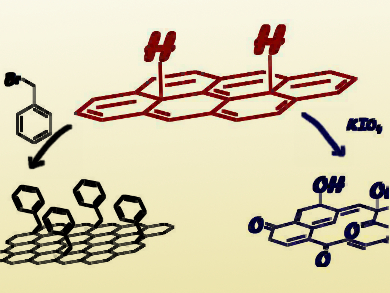The unique strength and conductivity of graphene make it promising for application in countless fields. Chemically functionalizing the material allows its properties to be tuned for different applications. Hydrogenation is of particular interest since it unlocks graphene’s potential as a hydrogen-storage material.
Martin Kalbáč and colleagues, Academy of Sciences of the Czech Republic, Prague, have developed a method for the hydrogenation of graphene which was synthesized by chemical vapor deposition (CVD). This reaction was performed using H2 gas in an autoclave at 200 °C in 2 hours. A series of reactions could then be performed upon these hydrogenated “defect” sites on the graphene surface, including an oxidative C–C cleavage with KIO4, an oxidative dehydrogenation back into graphene with KMnO4, and an addition of benzyl groups through substitution with BnBr.
Functionalization of the surface with carbonyl and benzyl species could prove useful as a method of tuning the band gap of graphene. In addition, the dehydrogenation of the saturated units shows that hydrogen can be stored and removed. This could pave the way towards a non-oxidative dehydrogenation pathway, which would be crucial for the use of graphene as a hydrogen-storage material.
- Functionalization of Hydrogenated Chemical Vapour Deposition-Grown Graphene by On-Surface Chemical Reactions,
Karolina Drogowska, Petr Kovaříček, Martin Kalbáč,
Chem. Eur. J. 2017.
DOI: 10.1002/chem.201605385




